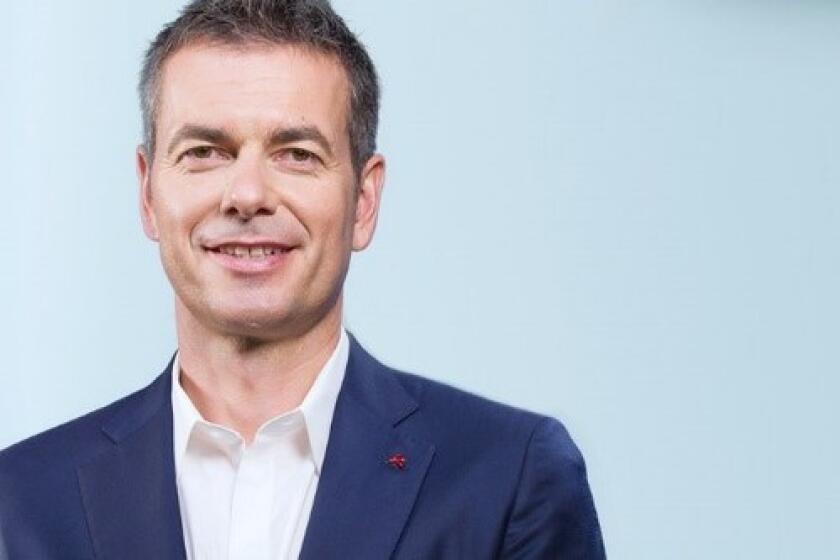‘Changing the Focus: Latin American Photography 1990-2005’ at the Museum of Latin American Art
- Share via
“Changing the Focus: Latin American Photography 1990-2005” doesn’t pretend to be a comprehensive survey. Thankfully.
It’s not an act of curatorial acrobatics that forces disparate works together through conceptual stretching and contextual twisting. Instead, it’s a moderately scaled sampling, thoughtful, but not oppressively thought-out. Anchored by familiar names (Alfredo Jaar, Vik Muniz, Gabriel Orozco) and leavened by lesser-knowns, the show -- at the Museum of Latin American Art in Long Beach -- doesn’t strain to make a case for itself. The mostly well-selected work is convincing enough.
The exhibition’s title defines its geographic and chronological parameters, but those factors recede once inside the show. Curator Idurre Alonso instead maps the impossibly broad terrain of recent Latin American photography according to varieties of pictorial approach: documenting reality, theatricalizing it or creating an artificial alternative. The strategies are general enough to apply to photographic work from any part of the world and pretty much any time period, but they impose just enough structure to help organize the show’s 80-plus works by 37 artists from a dozen different countries.
The dividing lines between the categories are porous, and numerous works could fit comfortably into more than one section of the show. The team of Aziz + Cucher’s creepily compelling, deftly manipulated images of corridors whose every surface is made of human skin hang alongside imagery of the urban landscape; they are theatrical and contrived as much as they are rooted in the actual. Similarly, Ronald Morán’s scenes of domestic interiors encompass both the real and the surreal. Every surface in both the kitchen and child’s bedroom is white, as if they were encrusted with sugar or encased, like a Pompeian ruin, in ash.
A handful of the artists -- who hail from Cuba, Venezuela, Mexico, Peru, Argentina, Brazil and Ecuador, among other countries -- address place overtly in their work.
Melanie Smith doubles a hazy, aerial shot of Mexico City’s dense sprawl, tilting the mirrored halves together to form a city-sized drainage channel, a mildly unsettling urban Rorschach. Jaime Ávila riffs on the minimalist cube by stacking into a one-meter square 1,000 paper boxes printed with aerial photographs of Tijuana’s messy, provisional growth. Ávila’s imperfect cube -- not a profound piece, but slightly provocative -- resonates well with pictures of building projects by Alexander Apóstol, Manuel Piña and Carlos Garaicoa, all of them highlighting the disparity between utopian ideals and flawed physical reality.
Audio commentary on some of the work is accessible in the galleries by cellphone, and it can be useful to get a bit of traction on the imagery. Otherwise, there are only generalized wall texts introducing each of the exhibition’s sections. The distinct complexes of historical, art historical, religious, cultural and political forces that each artist is responding to don’t get parsed in the show (and not very thoroughly in the catalog, either), but substantive social issues clearly drive most of the work. Abstraction or a purer sort of formalism are minor currents.
That said, several of the strongest images in the show have a pared-down beauty, quite poetic in its power. In the achingly poignant, “El hombre con lágrimas de pájaro (Man With Bird Tears),” Mario Cravo Neto tightly frames a man’s face, his eyes covered by a pair of small bright birds gently pinched between his fingers. Tatiana Parcero overlays acetate images of her nude body atop sepia-toned prints of maps or ancient codices, so that the drawings tattoo her skin, asserting an intimate connection with a place and its past.
Milagros de la Torre presents a stunning grid of 15 black and white images of hand-held weapons. A cross between portraits and still lifes, the pictures show each sharp tool isolated against a black background, a slash of light and danger emerging from the darkness. The handle of one knife is wrapped in string, another in tape. Crude gems, they testify to the resourcefulness of violence.
Toughness comes in a variety of forms throughout the show: in the chilling, vividly staged autopsy scene by Marcos López; in Teresa Margolles’ pictures showing cocaine being cut by cards printed with horrific morgue shots of victims of drug-related crime; and in the garish, outlandish anti-icons of Nelson Garrido, one featuring a Christ with three strapped-on stuffed penises, and the other showing a slickly oiled and shaved Mary poised to stab her just-delivered infant Jesus.
Humor and irony have their place here, as do searing critiques of class and consumerism, as well as personalized takes on ritual, belief and memory. The youngest artists in the show were born in the mid-1970s, the oldest in the early 1940s. That generational span is part of what gives this show, which suffers only a few flat spots, its rich texture and range. Curator Alonso assigned the exhibition a supersized purview, but its ambitious scope isn’t what makes the show engrossing -- it’s the ambitious work within.
More to Read
The biggest entertainment stories
Get our big stories about Hollywood, film, television, music, arts, culture and more right in your inbox as soon as they publish.
You may occasionally receive promotional content from the Los Angeles Times.










